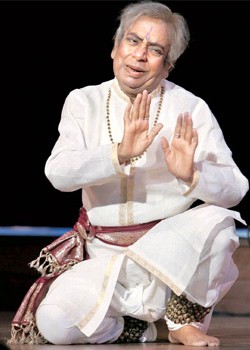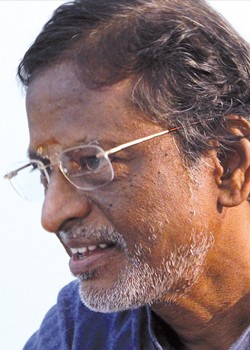COVER STORY
BIRJU MAHARAJ - Kathak colossus
LEELA VENKATARAMAN

The Lucknow gharana of Kathak is Pandit Birju Maharaj’s birthright. He is the grandson of Kalka Maharaj – who, with his brother Bindadin Maharaj, became a rare Kathak jewel in the court of Nawab Wajid Ali Shah. He is the only son of Achhan Maharaj, the eldest of three geniuses born to Kalka Maharaj, and the nephew of the legendary Lachhu Maharaj and his younger brother Shambhu Maharaj. He represents the seventh generation of Kathak luminaries in a lineage traced from Ishwari Prasad, the founder of the tradition.
Birju Maharaj was born in 1938. It was a watershed year when Kathak, like other dances, was facing vanishing royal patronage. Performers like tawaifs and bais were on their last legs, and the fervour of nationalism was triggering a new generation of aspirants on a journey of rediscovering their lost Indian identity, eager to know about and learn traditional dance forms.
By a quirk of destiny, Birju Maharaj came to be the right man at the right place in 1953, when Kapila Vatsyayan (then Kapila Malik) brought him from Lucknow to Delhi to teach at the Hindustani School of Music and Dance (later named Sangeet Bharati). Much water had flowed under the bridge by then. Young Birju, not a stranger to Delhi, had as a seven year-old accompanied his father Achhan Maharaj, when Nirmala Joshi invited him to teach at the same school. Kapila Malik, Leela Kripalani, G.R.Gupta and Usha Bhatia were among those who enrolled as students.
COVER STORY
MALAVIKA SARUKKAI - A voyage of self-discovery
V. RAMNARAYAN

She took the dance world by storm in the 1980s. Even first-time rasikas of dance were overwhelmed by her dazzling footwork and her clean lines. She came as a breath of fresh air into a phase in the development of the Bharatanatyam performance space when ageing divas were beginning to resort to their superior abhinaya strength to counter the challenge of slowing limbs.
Already a decade or more into her dancing career after her debut at the age of 12, Malavika Sarukkai was at the time perhaps the most exciting pupil of her gurus T.K. Kalyanasundaram Pillai of the Tanjavur school and S.K. Rajaratnam Pillai of the Vazhuvoor school of Bharatanatyam, impressing the critic and the commoner alike. She had by then also been studying the nuances of abhinaya from Kalanidhi Narayanan for some years.
Yet even as she electrified audiences with the power and precision of her nritta, Malavika was not yet known for abhinaya excellence, tending to wear a uniformly intense expression. Her years of hard work had made her a breathtaking performer of aesthetic excellence, but she had perhaps not begun to ask the questions whose answers or the new questions they led to would propel her art into an altogether more philosophical, more emotional new trajectory. It was a prolonged period of high-voltage performances and enthusiastic audience approbation.
THEATRE
FIRST PERSON - KOOTHU-P-PATTARAI - The early days
PROF. E.R. GOPALAKRISHNAN

It was a fashion in the early 1970s to drop names like Che-Guevara, Pablo Neruda to project yourself as different and progressive. It was a kind of branding in a soft form. In recent times Koothu-P-Pattarai has become a sort of brand for many. These days, many new actors in movies make it a point to declare their association with Koothu-P-Pattarai or their training there. I am indeed happy about the publicity it generates for the organisation, but it amuses me when I reflect on the beginnings of Koothu-P-Pattarai.
It was sometime during 1976-77 that Na. Muthuswamy supported by ‘Pragnai’ Rangarajan (aka Veerachamy) was crusading the cause of Terukoothu, with the cooperation of Cre-A Ramakrishnan. (Na. Muthuswamy’s Naarkalikkarar was published in Pragnai magazine.) Their immediate task was threefold. The first was to mobilise resources to rehabilitate Terukoothu. The second was to work towards gaining acceptability for Terukoothu in the ‘cultural space’ of Chennai. The third was to persuade Purisai Kannappa Sambandham to return to his village and learn whatever he could from his father Purisai Kannappa Thambiran instead of driving an autorickshaw in Chennai for his livelihood. Na. Muthuswamy and Cre-A Ramakrishnan provided financial cushion to Sambandham during that period; it was a wonderful gesture given their personal constraints. Their efforts were not wasted, going by the recognition Purisai Kannappa Sambandhan enjoys today as a leading Terukoothu exponent and the recognition gained by Terukoothu in the classical milieu of Chennai. There was some criticism that Muthuswamy was trying to remove the rustic element and raw beauty of Terukoothu and that he was killing the true spirit of the form. There were others who hailed and compared his endeavour with Dr. Shivarama Karanth’s efforts in reviving Yakshagana in Karnataka.
NEWS & NOTES
Homage to Lalgudi in Boston
DURGALAKSHMI KRISHNAN

MITHAS (Massachusetts Institute of Technology Heritage of the Arts of South Asia) and Chinmaya Mission, Boston, are two organisations enriching the cultural life of the Boston area for more than 20 years. Established in 1993 by Dr. George Ruckert, a disciple of Ali Akbar Khan, and a Senior Lecturer in the World Music Department at MIT and dedicated to present quality music and musicians from across the globe through concerts, work shops and lecture demonstrations, MITHAS has gained the respect of both artists and audiences. The Chinmaya Mission, Boston, has more than 500 children and adults attending several classes in music, dance and other arts. These two organisations recently held events honouring the memory of violin maestro Lalgudi G. Jayaraman.
The first was the launch of the biography of the maestro titled An Incurable Romantic: The Incredible Journey of Lalgudi Jayaraman written by Lakshmi Devnath, organised by MITHAS at the MIT campus in Cambridge, Massachusetts, on 29 September 2013. Scholar, musician and writer Sujatha Vijayaraghavan was the guest speaker at this event. She elucidated several key points and interesting anecdotes of Lalgudi Jayaraman’s life from the book, along with her own experiences when she was collaborating with him at the time when he was composing his magnum opus Jaya Jaya Devi for dance. She also went on to explain how the title, An Incurable Romantic, aptly describes him and released the book that was received by Dr. George Ruckert.


